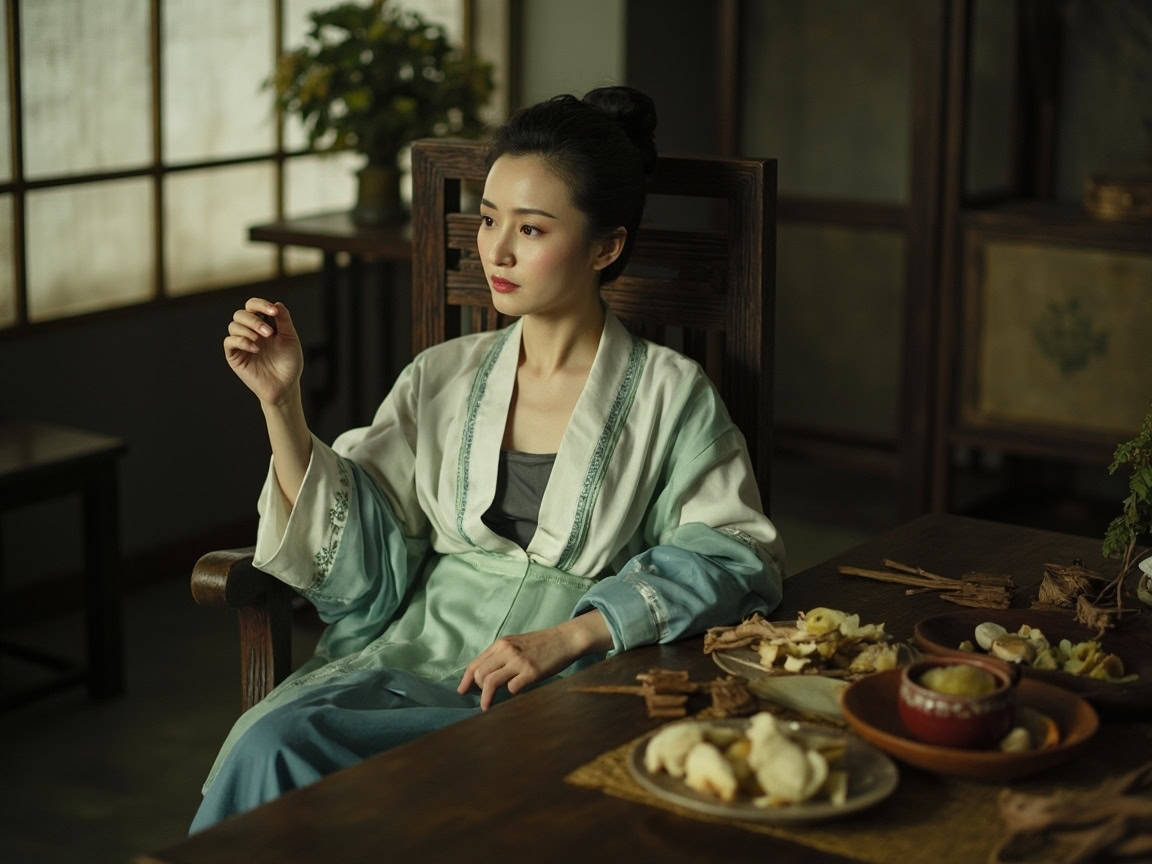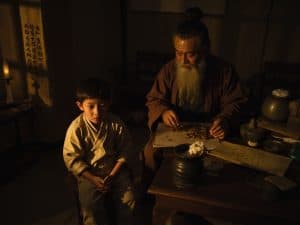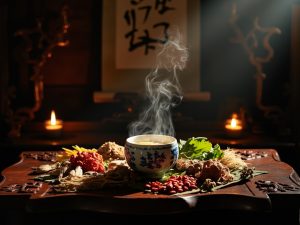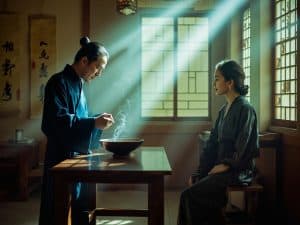Table of Contents
ToggleTraditional Chinese Medicine Case Analysis 3:Hand numbness, sweating, pale complexion
Author: Gu Yuxi Editor: Gu Yuxi Translator: Gu Yuxi
Traditional Chinese Medicine Case Study from “Luo Jiao Annotation of Guilin Ancient Edition of Shanghan Zabing Lun” – [Huangqi Guizhi Wuwu Tang for Treating Hand Numbness]
Original Text:
Wang, female, 42 years old. For the past two months, she has frequently experienced numbness in her upper arms, with electric-shock-like sensations radiating from the arms to the hands, and numbness in her fingertips. Her complexion was pale white (㿠白), she was prone to sweating, had a normal appetite, and normal bowel movements. Her tongue proper was pale red with a white coating, and her pulse was thin and thready. Huangqi Guizhi Wuwu Tang was prescribed: unprocessed Huangqi (Astragalus) 30g, Guizhi (Cinnamon Twig) 20g, unprocessed Baishao (White Peony Root) 20g, fresh Shengjiang (Ginger) 15g, 3 Dazao (Jujube) (sliced) as a guide. After taking the formula for two weeks, all symptoms resolved!
【Traditional Chinese Medicine Syndrome Differentiation Approach】:
Differentiating Six Diseases:
- Difficulty with urination : None. Bowel movements are normal.
- Taiyang Disease : No clear key symptoms, but there are exterior symptoms. For the past two months, she has frequently experienced numbness in her upper arms, with electric-shock-like sensations radiating from the arms to the hands, numbness in her fingertips, pale complexion, and proneness to sweating.
- Yangming Disease : None. Bowel movements are normal.
- Shaoyang Disease : None.
- Shaoyin Disease : None.
- Taiyin Disease : None. Appetite is normal.
- Jueyin Disease : None.
Differentiating Miscellaneous Diseases:
- Qi Deficiency : Present. For the past two months, she has frequently experienced numbness in her upper arms, with electric-shock-like sensations radiating from the arms to the hands, numbness in her fingertips, pale complexion, and proneness to sweating.
- Blood Deficiency : Present. For the past two months, she has frequently experienced numbness in her upper arms, with electric-shock-like sensations radiating from the arms to the hands, numbness in her fingertips, pale complexion.
- Water-Dampness : None.
- Food Stagnation : None.
- Phlegm Obstruction : None.
- Blood Stasis : Possibly present.
- Other Miscellaneous Diseases: Xuebi disease (Blood Bi disease) is present. For the past two months, she has frequently experienced numbness in her upper arms, with electric-shock-like sensations radiating from the arms to the hands, numbness in her fingertips, and a thin and thready pulse.
Summary:
This is a very standard case of Xuebi disease, with some exterior symptoms similar to Taiyang disease, and also symptoms resembling both qi and blood deficiency. However, in Shanghan Zabing Lun, Zhang Zhongjing provides a clear treatment method: [13.18] “Question: How is the disease of xuebi acquired? Master says: A person of noble status, with weak bones and abundant flesh, further due to fatigue and sweating, lying down without timely movement, and exposed to a slight breeze, thus acquires it. The pulse at the Cunkou is faint and thready, and at the Guan position slightly tight. It is advisable to use needling to guide yang qi outwards; when the pulse is harmonious and the tightness subsides, it will heal.” This refers to guiding yang qi outwards with needling. This means that in classical formulas, the focus is on guiding yang qi to the exterior. Therefore, unprocessed Huangqi is heavily used. Additionally, the treatment is similar to that for Taiyang wind-stroke syndrome, hence the use of Huangqi Guizhi Wuwu Tang.
Shanghan Zabing Lun Clause Corresponding to This
Traditional Chinese Medicine
Case:
Differentiating Xuebi Xu Lao Disease Pulse Patterns and Treatment 13.19—[13.19] “Xuebi, both yin and yang are faint, or the pulse at the Cunkou and Guan is faint, and at the Chi position slightly tight, with external symptoms of body numbness, resembling Wind Bi syndrome, Huangqi Guizhi Wuwu Tang is indicated.”
Most of the main symptoms in the case study are exactly the same as in this clause, except for the pale complexion and proneness to sweating. These two symptoms both indicate deficiency, where yang is not consolidated and the exterior is not firm. This classical formula can also resolve these incidentally.
Hu Xishu’s Interpretation of This Clause:
What is xuebi? “Yin and yang are both faint” means that the pulse is faint whether felt lightly or pressed hard, indicating both exterior and interior faintness. “Yin and yang” have various interpretations. Some refer to “upper and lower” (Cun, Guan, Chi pulses), indicating locations; the Cun pulse is often called “Yang,” and the Chi pulse “Yin.” Sometimes it refers to “floating and sunken,” meaning a pulse felt lightly (floating) is “Yang,” and a pulse felt heavily (pressed hard) is “Yin,” used for internal differentiation.
“Yin and yang are both faint” does not refer to upper and lower, because “Cunkou” follows it. Therefore, it refers to floating and sunken; when pressed lightly, the pulse is faint, and when pressed heavily, the pulse is also faint. This indicates insufficient jinye (body fluids). Where is the jinye insufficient? In the exterior. “Cunkou and Guan are faint,” meaning the pulse at the Cunkou is faint whether floating or sunken, which is the same as above. Where is the jinye insufficient? Insufficient in the exterior; “Chi is slightly tight,” similar to “below the Guan,” the Chi pulse corresponds to the interior, indicating that wind-cold has entered the interior.
The pulse also has no significant difference from the previous discussion; it means that wind-cold, leveraging exterior deficiency, has damaged the blood, thus resulting in xuebi syndrome. This is the ancient perspective.
“External symptoms of body numbness” refers to the numbness and lack of sensation in the body in xuebi disease. “Resembling Wind Bi syndrome” means it’s similar to Wind Bi, also having numbness, but Wind Bi usually involves pain, while xuebi does not. This disease is very common. “Huangqi Guizhi Wuwu Tang is indicated.” The preceding clause stated, “It is advisable to use needling to guide yang qi outwards,” and here a formula is presented; this formula is equivalent to “guiding yang qi outwards” with needling.
Everyone should pay attention to Huangqi (Astragalus). The ancients said Huangqi supplements the Middle Jiao and boosts qi; it is a sweet and warm herb. All sweet herbs strengthen the stomach, thus “supplementing the Middle Jiao.” When the stomach is strong, the qi from water and grains can sufficiently fill the exterior. The qi from water and grains is refined qi, which is jinye; both are nourishing substances. When do we use Huangqi? When there is exterior deficiency. What kind of deficiency?
The two preceding pulses both indicate insufficient jinye in the exterior. Jinye is the complex of water and grains transformed from food, plus oxygen. In short, it is nutritional components. If nutritional components are insufficient in the exterior, the exterior nutrition is inadequate, which is malnutrition. Due to malnutrition, many diseases will appear in this area, like what Western medicine calls sensory nerve paralysis. Peripheral nerves are external, and if they lack nutrition, they cannot bear it. Skin and muscles, if diseased, will develop sores.
The “yang qi” mentioned in Zhang Zhongjing’s writings consistently refers to jinye. In more colloquial terms, it refers to the nourishing components that sustain a person. When we eat food, blood vessels absorb it and transport nutritional components to various tissue cells. The ancients called what is inside the blood vessels “ying” (nutritive qi), also called “blood”; blood is the substance, and ying is its function. What is outside the blood vessels is called “wei” (defensive qi), also called “qi.”
TCM calls this exterior deficiency syndrome, also known as disharmony of ying and wei. Guizhi Tang (Cinnamon Twig Decoction) is used. Adding Huangqi to exterior deficiency can treat it.
Formula: Huangqi Guizhi Wuwu Tang
Source: Shanghan Zabing Lun
Composition: Fresh Ginger 6 liang White Peony Root 3 liang Astragalus 3 liang Cinnamon Twig 3 liang Jujube 12 pieces The above five ingredients, use six sheng of water, decoct to get two sheng. Take seven ge warm, three times a day.
Hu Xishu’s Dosage:
Dosage: Astragalus 9g, Cinnamon Twig 9g, White Peony Root 9g, Fresh Ginger 18g, Jujube 4 pieces. (Calculated at 1 liang = 3g)
Hu Xishu’s Formula-Pattern Correspondence:
Huangqi Guizhi Wuwu Tang is Guizhi Tang with Licorice removed and Huangqi added. Why remove Licorice? It is to guide yang qi outwards, to make the qi reach the exterior quickly. Fast-acting formulas do not use Licorice, as Licorice is a slow-acting herb. Here, Huangqi Guizhi Wuwu Tang syndrome requires yang qi to quickly exit to the exterior, so Huangqi is added, and Licorice is not used. Guizhi Tang within it regulates ying and wei.
According to the Bencao (Materia Medica), Huangqi treats “large malignant sores.” Therefore, Huangqi is most often used for diseases related to sores and carbuncles. The principle is the same: if there is malnutrition in this area, it cannot recover (this is one reason); secondly, if this area is deficient, it cannot dispel external evil. Dispelling external evil is a function of the human body, naturally capable of expelling external evil. Currently, this area is malnourished, so it needs to supplement the Middle Jiao and boost qi.
Many diseases, such as Huanghan (Yellow Sweat), and malignant sores caused by malnutrition in the skin, are due to deficiency in this area. What herb to use? Huangqi. The role of Huangqi lies here. Later generations mistakenly considered Huangqi to supplement qi in general, even for lung diseases, which is a big mistake; it does not supplement that kind of qi.
I frequently use this Huangqi Guizhi Wuwu Tang pattern; this formula is indeed very effective. If we see more severe blood deficiency, we can add some blood-tonifying herbs, often combined with Danggui Shaoyao San (Tang-Kuei and Peony Powder).
The medication should be adjusted and varied according to the evolution of the syndrome. Since the changes in this type of disease are minimal, this single formula is often used. Of course, clinically, with the in-and-out changes of syndromes, this formula can be modified. For nerve paralysis presenting with Huangqi Guizhi Wuwu Tang syndrome due to that particular cause, if there are other problems and other syndromes arise, then different formulas can be adjusted according to different syndromes, but the main treating formula is still correct. We can add some medicinal ingredients or combine it with other formulas depending on the current situation.
Disclaimer:
The experiences and insights shared above represent the author’s personal usage and understanding, and are provided for reference only as part of academic exchange. Please do not blindly replicate or apply them; any consequences arising from such actions are solely your responsibility. As individual constitutions vary, medication should be tailored accordingly. It is advisable to use such treatments under the guidance of a qualified physician. If you have additional experiences to share, comments and submissions are welcome.
If you appreciate my article, please give it a like.
If you are a generous and affluent individual, please consider making a donation!
Your recognition is my greatest motivation to continue writing—thank you very much!
USD Donation Button —
A RMB donation button is available below.
 微信赞赏
微信赞赏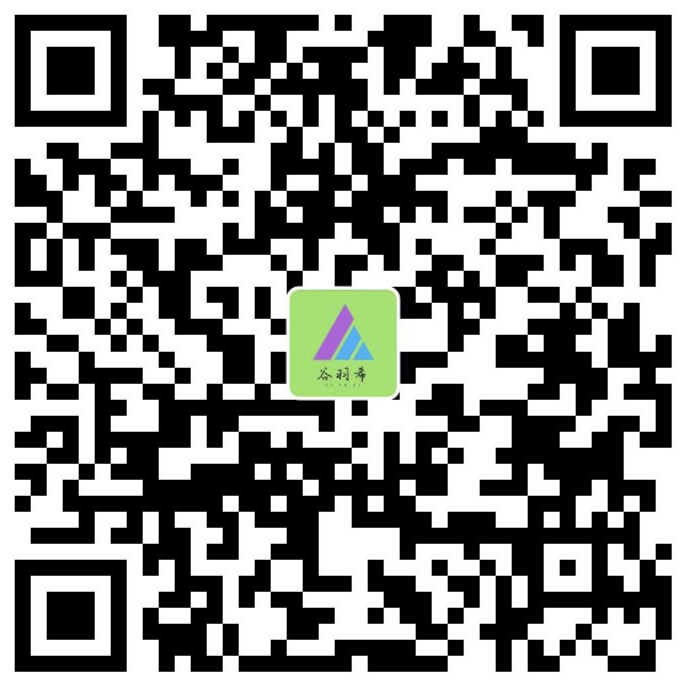 支付宝赞赏
支付宝赞赏

